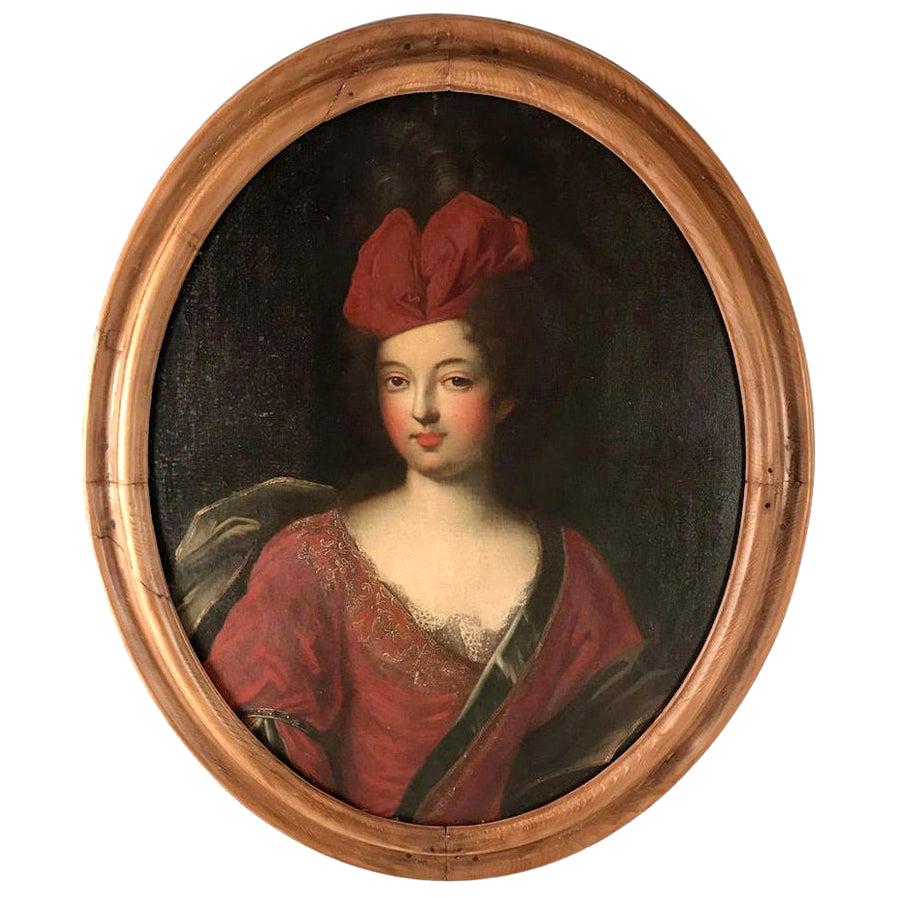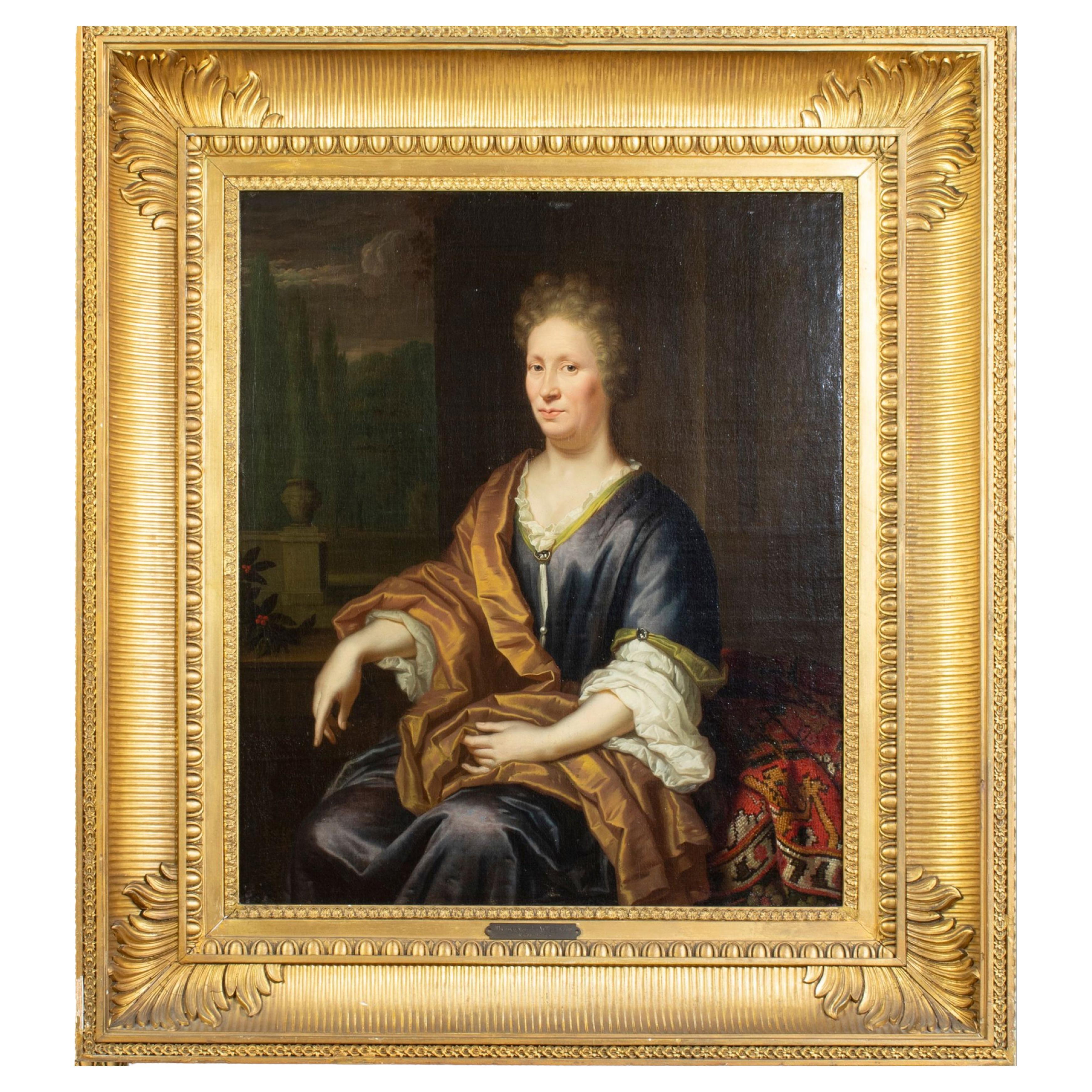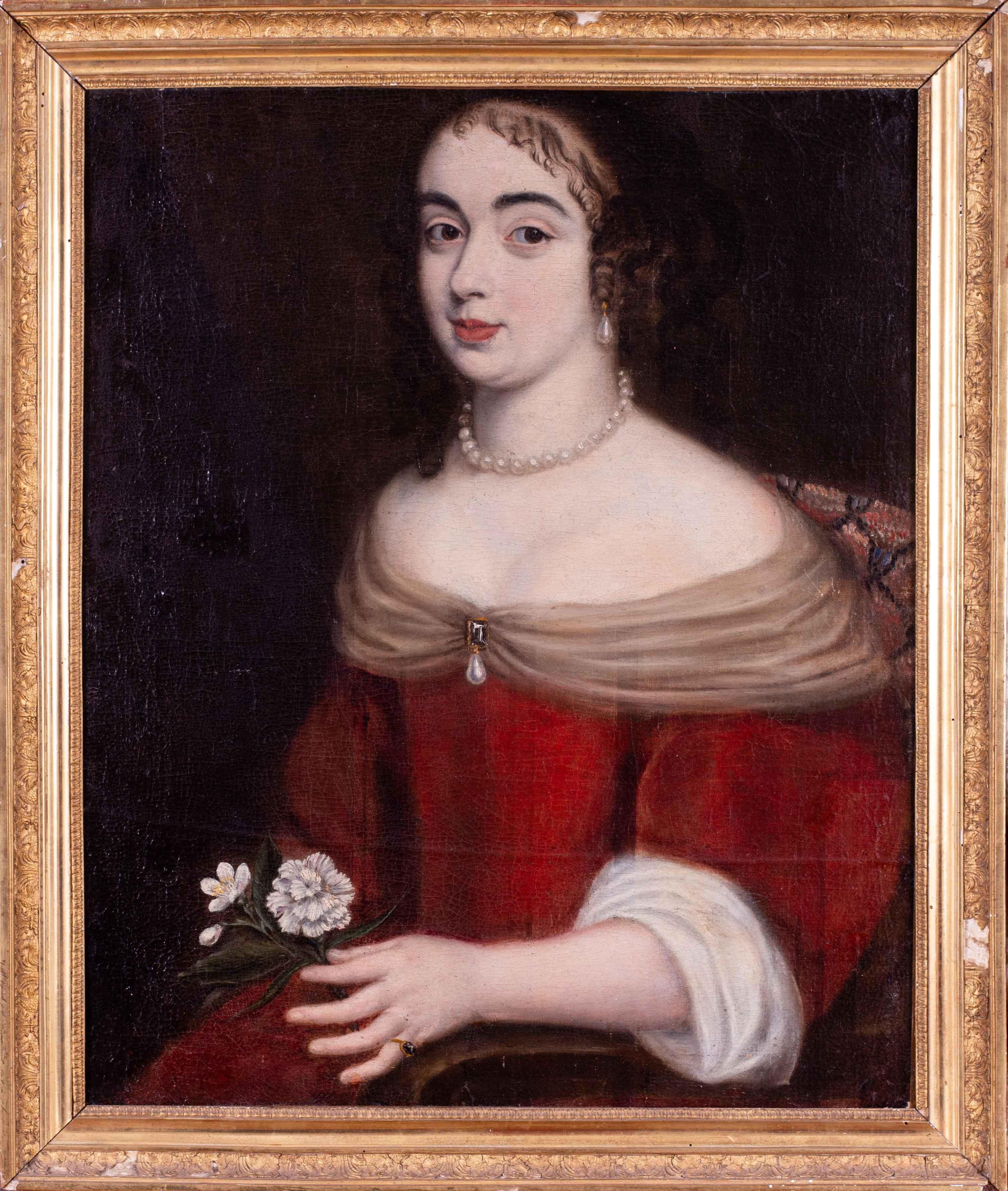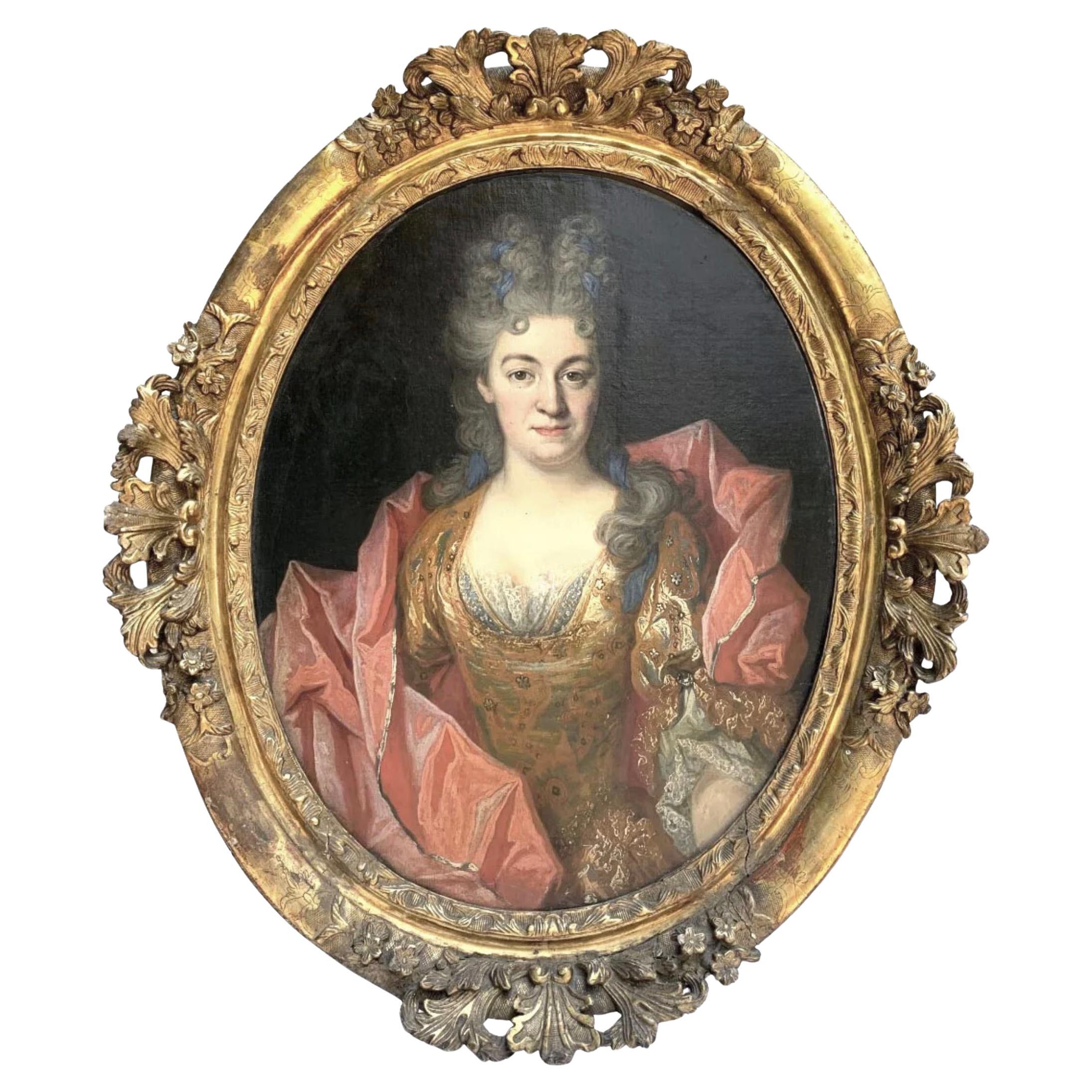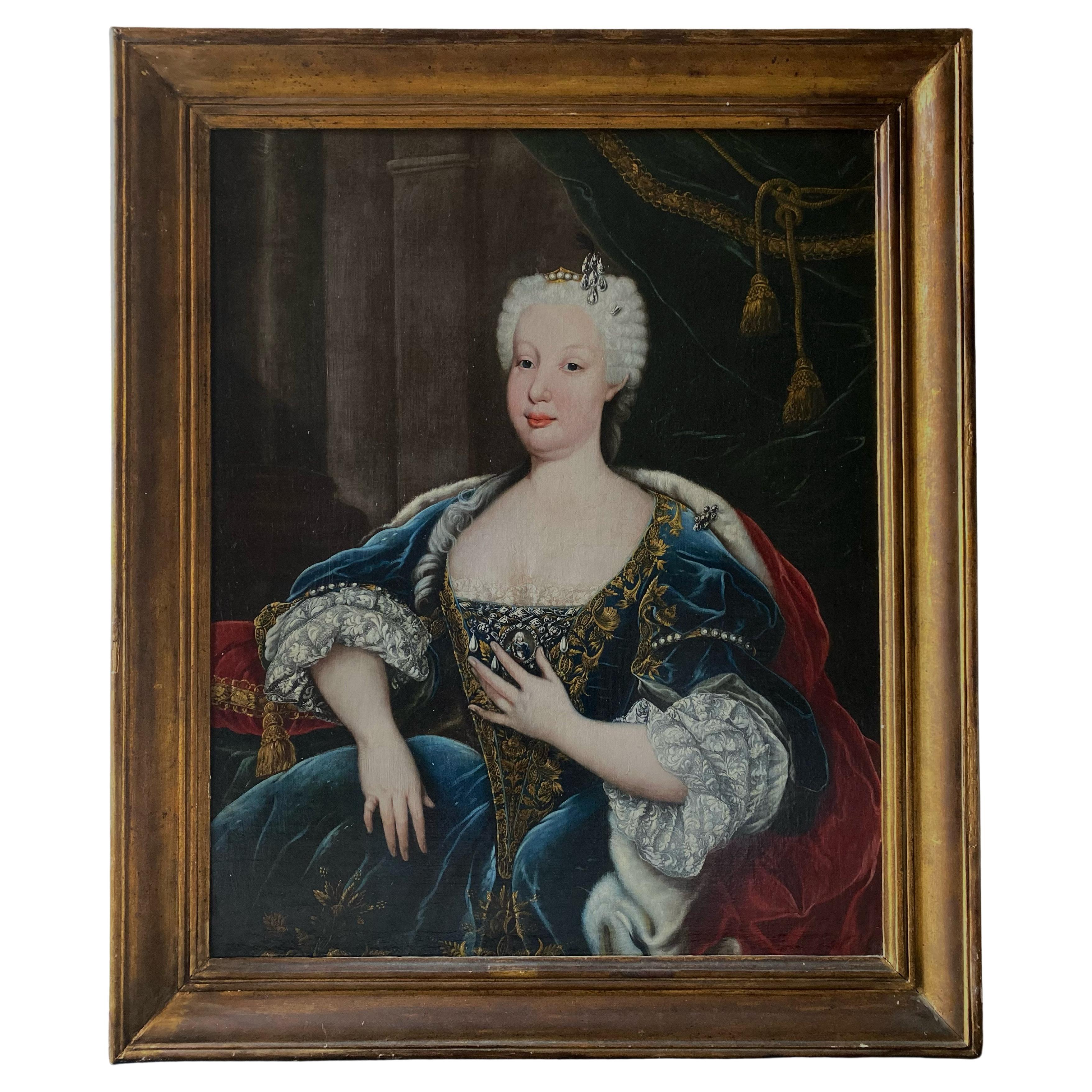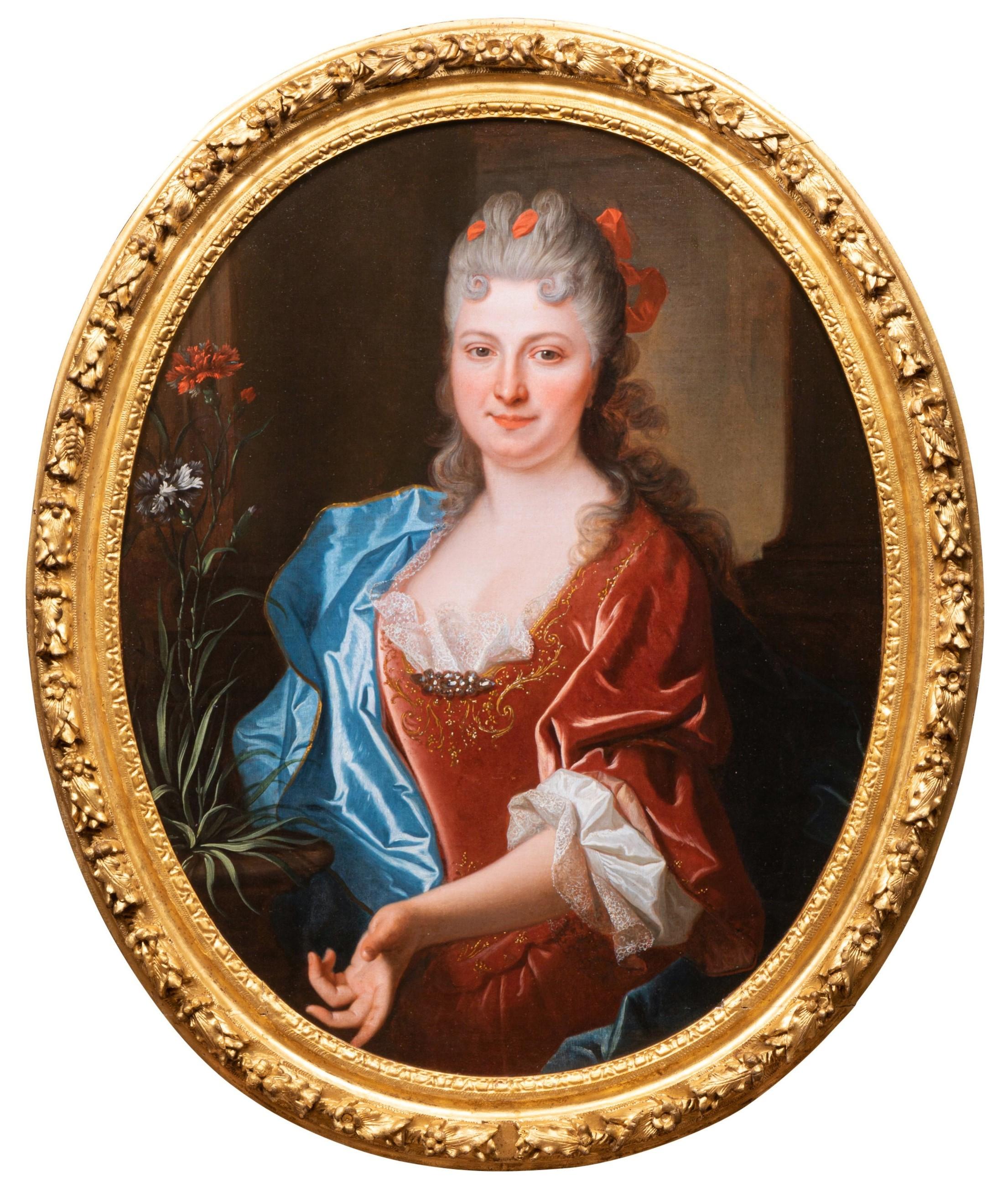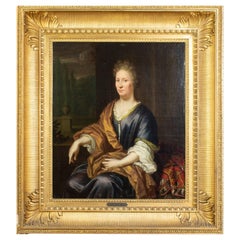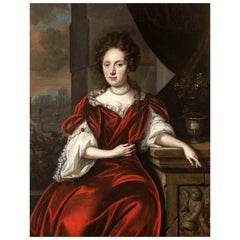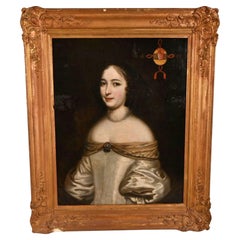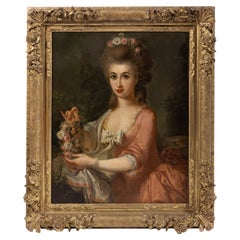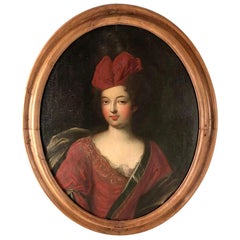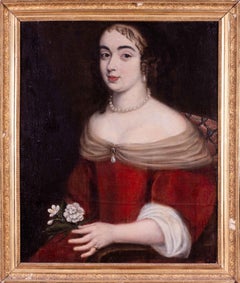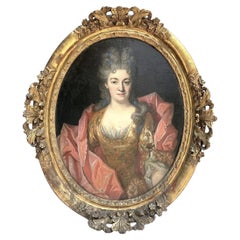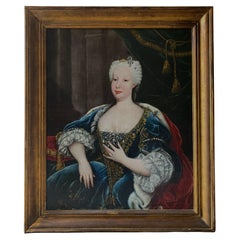Items Similar to 17th Century French School, Workshop of Jean Nocret "Portrait of a Woman"
Want more images or videos?
Request additional images or videos from the seller
1 of 11
17th Century French School, Workshop of Jean Nocret "Portrait of a Woman"
$8,839.67
£6,658.03
€7,500
CA$12,190.28
A$13,695.24
CHF 7,155.78
MX$167,156.78
NOK 90,857.54
SEK 85,523.23
DKK 57,087.15
About the Item
17th-century French School, workshop of Jean Nocret
Portrait of a Woman with a Desk
Canvas (Antique Restorations)
107 x 84.5 cm
Good condition
A student of Jean Le Clerc, a Lorraine master, Nocret made an early training trip to Rome. There, he met Nicolas Poussin and made copies for Monsieur de Chantelou. Poussin, dissatisfied with the young artist's ambitions, wrote of him in 1643: "The most regrettable thing is that he has decided not to finish the portraits he has begun, giving no other excuse except that he found something to earn more by making 60 or 70 crowns."
He returned to Paris in 1644 and was appointed painter to the king in December 1649, valet to the king, and painter to Philippe, Duke of Orleans and brother of the king. He would soon be recognized as a great portraitist. In 1657, he left for Portugal with the French ambassador, Bishop of Comminges, where he produced portraits of the Portuguese royal family (including Infanta Catherine, Infante Pedro, and King Afonso). Returning to Paris in 1660, he was appointed to the interior decoration of the Saint-Cloud Palace, including mythological portraits and adorning the apartments of the Duchess of Orleans, most of which have since disappeared. It is known that one could admire Iris and her rainbow on the ceiling of a passageway, Venus and Mars in the chamber, and in the great cabinet: Thetis having Achilles' weapons forged by Vulcan, Perseus and Andromeda, Apollo and the Muses, Diana in her chariot, and on the ceiling of the great hall: The Marriage of the Duke and Duchess of Orleans.
The Family of Louis XIV as Olympian Gods, his most famous work (now in the Museum of Versailles and Trianon), was executed for the antechamber of the Duke of Orleans around 1670. Nocret entered the Royal Academy of Painting and Sculpture in 1663, with the presentation of The Repentance of Saint Peter.
Between 1666 and 1669, Nocret decorated the queen's apartments at the Tuileries Palace, under the direction of Charles Le Brun. These decorations disappeared in 1871 during the Tuileries fire. On the ceiling of the queen's antechamber were: Wisdom or Minerva with the queen's features; in the great queen's chamber: Glory and Fame above the doors; The Triumph of Minerva on the ceiling; and Fame and Glory on the arches; in the small queen's chamber: The Arts directed by Wisdom and three paintings depicting Loves on the ceiling; Architecture, Sculpture, Astronomy, Music, Fidelity, Innocence, and Wisdom on the walls; Vigilance and Faith above the oval doors; in the queen's boudoir: The Triumph of Minerva on the ceiling; The Tapestry, The Winder, Embroidery, Needlework above the door; and The Bath of Minerva and The Dispute on the walls.
Some works are attributed to him, such as Fame Presenting to France the Portrait of Louis XIV (Saint-Quentin, Antoine Lécuyer Museum, panel sometimes attributed to Louis-Ferdinand Elle), Portrait of Anne of Austria (Nantes, Museum of Fine Arts), Portrait of Louis XIV (Château de Maisons-Laffitte), and Portrait of Louis XIV as a Roman General (around 1670, Sceaux, Ile-de-France Museum).
Nocret married Antoinette Vuyet, with whom he had five children: Jean-Baptiste (1647), Jean-Charles (1648), Jean-Simon (1649), Marie (1650), and Antoinette-Geneviève (1651).
His son, Jean-Charles Nocret (Paris, 1648 – Paris, 1719), was not only a portraitist but also a painter of historical scenes. First valet to the Duke of Orleans, he joined the Academy in 1674, presenting a portrait of his father (National Museum of the Châteaux of Versailles and Trianon). In 1675–1676, he participated in the decoration of the queen's grand apartment at Versailles. His work, *The Renunciation of Louise de la Vallière* (1675, Brest, Museum of Fine Arts), is preserved. On 21 November 1681, Philippe I and his wife, Prince of Orleans, were godparents to a daughter of Jean-Charles Nocret.
- Creator:Europa (Artist)
- Dimensions:Height: 42.13 in (107 cm)Width: 33.27 in (84.5 cm)Depth: 3.94 in (10 cm)
- Style:Baroque (Of the Period)
- Materials and Techniques:Paint,Oiled
- Place of Origin:
- Period:
- Date of Manufacture:17th Century
- Condition:Wear consistent with age and use. good condition.
- Seller Location:Madrid, ES
- Reference Number:1stDibs: LU5779245505182
About the Seller
4.8
Platinum Seller
Premium sellers with a 4.7+ rating and 24-hour response times
Established in 2005
1stDibs seller since 2021
364 sales on 1stDibs
Typical response time: 1 hour
- ShippingRetrieving quote...Shipping from: Madrid, Spain
- Return Policy
Authenticity Guarantee
In the unlikely event there’s an issue with an item’s authenticity, contact us within 1 year for a full refund. DetailsMoney-Back Guarantee
If your item is not as described, is damaged in transit, or does not arrive, contact us within 7 days for a full refund. Details24-Hour Cancellation
You have a 24-hour grace period in which to reconsider your purchase, with no questions asked.Vetted Professional Sellers
Our world-class sellers must adhere to strict standards for service and quality, maintaining the integrity of our listings.Price-Match Guarantee
If you find that a seller listed the same item for a lower price elsewhere, we’ll match it.Trusted Global Delivery
Our best-in-class carrier network provides specialized shipping options worldwide, including custom delivery.More From This Seller
View AllThomas VAN DER WILT (1659-1733) "Portrait of Noble Woman"
By Europa
Located in Madrid, ES
Thomas VAN DER WILT (1659-1733) "Portrait of Noble Woman",
oil on canvas
55cm x 46cm without frame
65cm x 56cm with frame
very good conditions
Thomas van der Wilt (1659–1733) was an...
Category
Antique Early 18th Century Dutch Baroque Paintings
Materials
Paint
Reinier de la Haye (1640-1695) - PORTRAIT OF A LADY IN FRONT OF A PARK LANDSCAPE
By Reinier De La Haye
Located in Madrid, ES
Reinier de la Haye (1640-1695) - PORTRAIT OF A LADY IN FRONT OF A PARK LANDSCAPE Signed R. de la Haye on the right on the architectural base. Seated figure of a noble lady, dressed i...
Category
Antique 17th Century Dutch Baroque Paintings
Materials
Paint
French School 17th Century"Portrait with Coat of Arms Margueritte de Boutteville
Located in Madrid, ES
French School of 1659 17th century
"Portrait with Coat of arms of Margueritte Pierre de Boutteville"
around 1659
Oil on canvas with coat of arms and dated top right Provenance:
Bel...
Category
Antique 17th Century French Baroque Paintings
Materials
Paint
FRENCH SCHOOL "Portrait of a Girl with Flowers". 18th Century
By Europa
Located in Madrid, ES
FRENCH SCHOOL
"Portrait of a Girl with Flowers".
Oil on canvas from the 18th century.
Relined.
Dimensions: 80 x 64 cm
Good condition
Category
Antique 18th Century French Baroque Paintings
Materials
Paint
Entourage of Francois De Troy 'Toulouse 1645-1730 Paris' "Portrait"
Located in Madrid, ES
ENTOURAGE OF FRANCOIS DE TROY (TOULOUSE 1645-1730 PARIS)
Portrait of a young mulatto aristocrat
Oil on canvas
Measures: 80 x 63 cm.
Category
Antique 17th Century French Baroque Paintings
Materials
Paint
Important English School " LADY HAMILTON " 18th Century Sign
By Europa
Located in Madrid, ES
Important English School " LADY HAMILTON " 18th Century
Oil on canvas, 18th century English school.
Signed.
Small defects.
Dim.: 124 x 99 cm
good conditions
Category
Antique 18th Century English Baroque Paintings
Materials
Paint
You May Also Like
Late 17th Century Oil Portrait of a Lady
Located in Lymington, GB
An oil on canvas portrait of a young French courtier, circa 1690.
This evocative antique French-school picture has been attributed to the portrait painter Jean-François de Troy (1679-1752).
De Troy was famous as a portrait painter of fashionable society women.
This is a very attractive late-17th century painting surviving in its original frame and stretcher. The canvas appears to be untouched.
References:
'Jean François de Troy, The Alarm, or the Gouvernante Fidèle', at the Victoria and Albert Museum, London.
'Jean François de Troy, Paris 1679 - Rome 1752', at the Thyssen-Bornemisza Museum.
Laurie G. Winters, Troy, de, Grove Art Online, Oxford Art Online, Oxford University Press, 6 May 2016.
Everett Fahy & Jayne Wrightsman...
Category
Antique 17th Century French Paintings
Materials
Canvas
French School, 17th Century, 'Portrait of the Marquise de Grugieres', oil canvas
Located in Petworth, West Sussex
French school, 17th Century
Portrait of the Marquise de Grugieres
Oil on canvas
26.1/4 x 21.5/8 in. (66.7 x 54.8 cm.)
In a gilded composite frame, later production (possible early 1...
Category
17th Century Old Masters Portrait Paintings
Materials
Canvas, Oil
Circle of Nicolas de Largillière 1656 -1746 Portrait of a Noble Lady
By (circle of) Nicolas de Largillierre
Located in Rio De Janeiro, BR
This striking oval portrait, attributed to the circle of Nicolas de Largillière, exemplifies the refined elegance and artistic sophistication of late 17th to early 18th-century Frenc...
Category
Antique Late 17th Century French Baroque Paintings
Materials
Canvas
Portrait of D. Maria Bárbara De Bragança, Circle of Louis-Michel Van Loo
By H. van Loon
Located in Lisboa, PT
PORTRAIT OF D. MARIA BÁRBARA DE BRAGANÇA (1711-1758), QUEEN OF SPAIN
Circle of Louis-Michel van Loo (1707-1771)
Oil on canvas
Her Royal Highness, the Infanta Maria Barbara of Braganza (1711-1758) was the first-born child of King John V of Portugal (1689-1750) and his queen consort Maria Anna of Austria (1683-1754). Born in December 1711, she had the Convent Palace of Mafra built in her honour following a vow made by her royal father. Her status as Princess of Brazil, inherent to 18th century Portuguese presumptive heirs, would however be superseded once the queen gave birth to two male princes, D. Pedro (1712-1714) and D. José (1714-1777), preventing her from ascending to the throne.
Daughter of one of the most illustrious monarchs of his time, Maria Barbara was carefully educated to become a fond admirer of the arts, and of music in particular, having had the Italian composer Domenico Scarlatti (1685-1757) as her music teacher.
On the 10th January 1723 the young princess was betrothed to the Infante Ferdinand of Spain (1713-1759), eldest son of King Philip V (1683-1746). Six years later, on the 19th January, she entered her new country in a carefully choreographed ceremony that became known to history as the “Exchange of the Princesses”. This unique event took place on a specially built Bridge-Palace, a wooden, luxuriously decorated structure that included various modules and rooms, on both banks of the river Caia, the natural border between the town of Elvas in Portugal and of Badajoz in Spain. Simultaneously, on the same day that the Portuguese Infanta crossed the border to marry the Spanish Crown Prince, her new sister in law, the Infanta Mariana Victoria of Bourbon (1718-1781), her husband’s sister, crossed the same bridge in the opposite direction to marry Prince D. José, the Portuguese heir to the throne.
Once married, Maria Barbara would spend 17 years as Princess of Asturias, only becoming Queen of Spain at her husband’s accession following the death of Philip V in 1746. She is portrayed in the 1743 painting by Louis-Michel van Loo (1707-1771) now in the Prado Museum, in which Philip V had himself represented with all his close family.
The new Queen would take an important role at court eventually becoming the liaison between her husband and the King of Portugal, particularly throughout the negotiations for the Treaty of Madrid (1746-1750). Maintaining her interest in music, she patronized the Italian castrato singer Farinelli (1705-1782) while remaining close to her old master Scarlatti, having herself composed some sonatas for a large orchestra. She would also commission and fund the building of the Royal Salesians Monastery complex in central Madrid, where both her and Ferdinand VI are buried.
The portrait we are presenting for sale shows the Queen in half-length, turning left at three quarters. She is wearing a blue low-cut dress embroidered with flowers and foliage, over a lace cuffed white blouse, and an ermine cloak pined on the left-hand side by a diamond broach. The powdered hair style is held sideways by a seven diamond and black plume headdress and topped by a small gold and pearl crown. The right arm rests on a cushion while the left hand, at chest height, holds a miniature male portrait.
The Infanta’s features are analogous to the 1725 portrait by the painter Domenico Duprà (1689-1770), also in the Prado Museum collection. Further similarities can be found in another portrait by Louis-Michel van Loo, in which a seven diamond and black plume headdress is also present. In this work, the cushion supporting Maria Barbara’s right arm has also some obvious similarities to our painting. The same diamond headdress reappears in Van Loo’s above-mentioned portrait of Philip V’s family dated from 1743.
It is nevertheless in Lisbon’s Ajuda National Palace that it is possible to find an almost identical depiction of the Infanta holding a miniature portrait of her husband. In it, the future Ferdinand VI is portrayed facing right at three quarters and wearing a curly wig, suit of armour, the golden fleece insignia and a blue band, in a composition that closely resembles an 18th century Spanish school painting that appeared in the art market in January 2016.
Another detail common to various portraits of the Portuguese Infanta and Queen of Spain is the small gold and pearl crown on her head. In another Van Loo painting, also from the Prado Museum, in which Maria Barbara is portrayed as Queen, this crown is represented together with a headdress similar to the one previously described. Another two paintings by the same artist, at the Royal Academy of Saint Ferdinand, include the same ornament.
We must also refer the paintings by the artist Jean Ranc (1674-1735). In one, dating from 1729 (Prado Museum), the Infanta is depicted outdoors holding a flower bouquet and wearing a yellow silk dress with red cloak, and a set of diamond and ruby jewellery that includes a headdress similar to the one present in our portrait. Another work by the same artist, belonging to the Complutence University of Madrid, depicts the Infanta sumptuously dressed in identical colours to our painting and wearing an elaborate headdress and diadem.
These portraits, beyond their iconographical importance as contemporary records of the Infanta and Queen Maria Barbara, are also illustrative of 18th century fashion for jewelled head dressing. Often, flowers were combined with joyful adornments, composing almost theatrical displays that would reinforce the ostentatious nature of the image. The ornamental flowers and the chromatic character of the jewels would complement the luxury of the colourful dresses in blue, crimson, green or other silk shades, in compositions whose sole purpose was to highlight a royal sitter’s wealth and power, becoming an essential statement accessory within the strict court protocols and codes of conduct.
Circle of Louis-Michel van Loo (1707-1771)
Slowly but steadily, the resolute, tranquil and dignified attitude of Renaissance and Baroque portraiture becomes artificial and presumptuous. Mid 18th century society favours elusive expression and psychological deepness, albeit limited to the face, that, with emphasis on detail, on the rich colour palette and on changing costumes and landscapes, associated to the courtliness of gestures, creates a strongly artificial environment while maintaining a highly poetic intrinsic character.
Louis-Michel van Loo followed a dynasty of famous Dutch origin artists that had settled in France. Initially taught by his father, Jean-Baptiste von Loo (1684-1745), the younger van Loo studied in Turin and Rome and frequented the Paris Academy. In Rome he worked with his uncle Charles-André van Loo (1705-1765) and become a painter for the Turin Court. In 1737 he arrived in Spain being summoned by Philip V to succeed Jean Ranc as painter of the king’s chamber.
In Madrid, his work covers the numerous Court commissions and the Royal Saint Ferdinand Fine Arts Academy, of which he was a founding member and director for the Painting department in 1752. Is production at court consisted essentially of numerous portrait paintings, often Royal gifts...
Category
Antique 18th Century Spanish Baroque Paintings
Materials
Canvas
18th c. French Portrait of a Lady by Jean Ranc (1674 - 1735), Paris circa 1700
Located in PARIS, FR
Portrait of a Lady with carnations
By Jean Ranc (Montpellier 1674 - Madrid 1735), circa 1700
Oil on canvas in oval shape,
Dimensions: h. 35.82, w. 28.34 in.
Period Louis XIV giltwood and carved frame with laurel leaves.
Framed dimensions: h. 42.52 in, w. 33.85 in.
Provenance: Collection of the Marquis de Bailleul at the Château d'Angerville-Bailleul (before 1942).
To be included in the catalog raisonné of the artist by Stephane Perreau
Important portrait of a young woman depicted half-length turned three-quarters, her face looking at the viewer.
Dressed in a brick red velvet dress, an elegant blue scarf envelops her figure.
Hair styled “a la Fontange”, her powdered hair is raised and tied at the back with a red ribbon, several curly locks escape from her bun and fall on her back and shoulders.
The perfectly oval face with regular features dominated by her straight nose is softened by her gray eyes with slightly lowered lids. The red tinged skin tones on the cheeks and cheekbones color the face and make the portrait come alive.
The young woman is portrayed standing near a pot of carnations. Her strongly lighted figure stands out against an architectural background of columns.
The artist's palette is made of contrasts opposing warm to cold hues. The icy electric blue contrasts with the fiery brick red, the hair powdered with white accentuates even more the flush of the cheeks.
The left arm bent at the elbow, extending the open hand with slightly bent fingers in the foreground brings depth to the composition.
Our portrait, an interesting testimony in the corpus of works of the painter, is part of his youthful period, around 1700-1705.
The former belonging of this portrait to the Marquis de Bailleul reinforces the remarkable character of our painting.
The portrait has been examined by Stéphane Perreau, specialist of Jean Ranc and will be included in the catalog raisonné currently being written, under number P. 43. The notice edited by Mr Perreau is below:
"Painted around 1700-1705, this portrait of a woman is directly inherited from Hyacinthe Rigaud, the master of Jean Ranc (the hand turned over the front, in a watch...
Category
Early 18th Century Old Masters Portrait Paintings
Materials
Canvas, Oil
Portrait Mignard Paint Oil on canvsa Old master 17th Century French Lady Woman
Located in Riva del Garda, IT
Pierre Mignard, known as Le Romain (Troyes 1612 - Paris 1695), attributed
Portrait of 'Louise Renée de Penancoët de Keroualle, Duchess of Portsmouth and Aubigny (Brest 1649 - Paris 1734) as MADDALENA
Oil on canvas
97 x 88 cm
In an important gilded frame 132 x 122 cm.
Provenance: Private collection, Naples
The young and attractive noblewoman portrayed in this painting is Louis Renée de Penancoet de Keroualle, Duchess of Portsmouth and Aubigny (Brest 1649 - Paris 1734), known to have been King Charles II's favourite mistress for over fifteen years, from whose relationship Charles Lennox, 1st Duke of Richmond, was born, but above all to have gone down in history as one of Louis XIV's French informants at the English court.
The duchess was a very influential figure at court, promoting French interests and often acting as an intermediary between the king, his ministers and French ambassadors.
After the death of Charles II this influence quickly came to an end, forcing her to hastily leave London and renounce all her possessions to return to her homeland, between Aubigny-sur-Nère and Paris, where she died in 1734, always remaining in the sovereign's good graces.
The peculiarity of the portrait, probably executed after her return to her homeland, is that the noblewoman takes the form of a charming Mary Magdalene, depicted here following her renunciation of earthly possessions, her rich robes and jewellery, in order to aspire to heavenly riches; We see her immortalised with her long hair loose on one breast, her intriguing but serene gaze directed at the observer, as she rests her crossed hands, as if in prayer, on the ampulla of perfumed ointments and the open book, both iconographic symbols.
The custom of being portrayed in the guise of Magdalene was in vogue for powerful women of the great European courts as early as the 16th century, as it represented the most appropriate image to justify the union of female power and virtue. It must be said that court culture exalted only the positive characteristics of her personality, glossing over or downplaying all references to her sinful past and dissolute life.
The work, whose style fits perfectly into 17th century French portraiture, suggests the pertinent attribution to the Baroque painter Pierre Mignard (Troyes, 1612 - Paris, 1695), whose works were highly praised and earned him a great reputation as a portrait painter for the demanding Parisian aristocracy at the time of Louis XIV, and who portrayed the Duchess de Kérouaille on numerous occasions.
His first important artistic training took place in Simon Vouet's studio, and he then moved to Italy for over twenty years before returning to Paris, blending his own with the influence of Roman classicism.
The elegant looseness of touch and sensual refinement typical of Mignard, combined with a very accurate chiaroscuro rendering, inherited from his artistic training in Rome (which he looked up to the examples of Ferdinad Voet), and the exceptional sweetness of the drawing, the floridity of the complexion and the almost enamelled surfaces, and finally, the peculiar pose of the figure portrayed (the beauty of the two intertwined hands...
Category
17th Century Old Masters Paintings
Materials
Oil
$12,548 Sale Price
30% Off
More Ways To Browse
French Oval Portraits
Marie Versailles
Marie Antoinette Portrait
Portuguese Antique Door
Antique French School Desk
Charles And Diana
Achilles Sculpture
Painted Music Cabinet
Valet Cabinet
King Charles Desk
Mars And Minerva
Diana Of Versailles
Jean Louis Clerc
Quentin King
Egg Shell Table
Embroidered Peacock
Empress Josephine
English Chippendale Sofa
